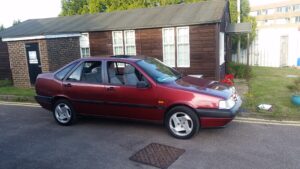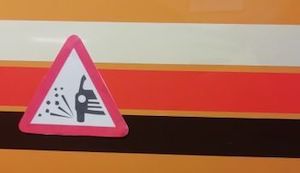It’s hard to believe that, as of 11th July 2025, Fabbrica Italiana Automobil Torino or Fiat will be 125 years old.

I was invited down to Beaulieu Motor Museum by Auto Italia magazine for a photoshoot to celebrate their top 5 within 125 models. They wanted my X1/9. It was to feature in their top 5 alongside a Panda, 128, Uno and 500—their top 5. A copy of Auto Italia is available here: https://t.co/BxVUB4nCup
Beaulieu should also get a special mention for being the home of the oldest known Fiat to exist. Seen as the central focal point in the cover of Auto Italia. Even Fiat Italy can’t claim this one. And people say all Fiats rust away in the UK. Proof if needed, that now all of them did.
And this got me thinking. 4 of the assembled cars were not in my top 5 and it would be interesting to see where my choices sat within Auto Italia’s choices.
Editor Chris Rees set out their premise and criteria. My criteria was going to be somewhat different. I was looking for Fiat’s that brought something emotive to me. That possibly altered the perceptions of the maker or humble models that spawned other models. In general, Fiat’s I liked the look of.
My choices may appear messy. At first glance, some might be difficult to justify to the motoring journalists who were there the first time around. So with that, let’s see where my top 5 go.
5. Fiat Strada 1978 – 1988
Auto Italia #59 (Regatta #91 Strada Abarth #26)

The Strada didn’t really do much for the motoring world. No fires were ignited. Even the Abarth models were overshadowed in the UK by the purchases of Escort XR3i’s and Golf GTi’s. A shame too because power for power, the all carb Strada was a monster.
What the Strada did was to change so much for Fiat in one big massive go. Visually it looked like nothing in the showroom. In 1978 Fiat had developed a reputation for making understated cars that were becoming unfashionable. The saloons all had a striking resemblance to one another.
Here then was a 5 door hatchback with big plastic bumpers that formed part of the design with form and function. The fact that these would be replaced by a simpler design 4 years later, showed that Fiat had been willing to take chances. They would continue this trend throughout the 80’s and 90’s.
Worker relations in Italy were always fraught at best. The Strada became synonymous with the start of robotised production. These robots wouldn’t jeopardise manufacture. They wouldn’t miss bolts out. They would weld where they were supposed to. They didn’t go on strike. For that at least, the Strada was as good as it was going to get in terms of build quality from Fiat.
For me, the Strada was striking in its looks. It took the dullness of the family hatchback and tried to reinvent design fun in the segment. Just look at the original asymmetrical wheel pattern. And then the round door handles. Small details that should have been appreciated by more. Just don’t look at the poverty facelift model. The single light base models looked startled at best like someone just tried to shove a chocolate eclair up its bum!
4. Fiat 132 1972 – 1981
Auto Italia # 116 (Argenta #122)

I don’t agree with Auto Italia’s rating for this one. A strong-worded letter was written to the editor Chris Rees. I even sent a letter to the Vatican. I was outraged of Driven It dot co dot UK. That said, it was correctly rated above the 2001 – 2007 Stilo.
Critics never took to the 132. The 125 was in some ways a posher 124 and was quite a car in this segment. It had engines to outperform sports cars and underpinnings that were advanced for the time. The 124/5 platform lent itself to 2 iconic sports cars, the Coupe and Spider.
In some ways, the critics did have a point. The 132 outpaced itself in terms of handling in that the front was indifferent to that on the rear. And the ride was let down for this.
Visually it was criticised for being dull. At the time it was as elegant in an aggressive way as the BMW 5 series. The 132 also presented the shark front that made it look like it was going fast even when parked. And it had quad lights. The visual signal that this was a sporting car.
Fiat tried to make you like it. It went through 3 body evolutions. So subtle that it was difficult to notice. And because the car was largely ignored, they were. And this is before we get to the Argenta. That also went through a stylising refresh. The Mafia are known for putting horse heads in bed. To be honest, it would have taken more than a bullet to the brain for people to want the Argenta
Engine choices were Italian tax-friendly with the 2 litre twin-cam at the top. An engine that is still revered as being something quite special. In the UK the 2 litre was top-shelf material. You could keep your Granada L. This was business class express.
Sadly the 132 became neglected by those who more-or-less threw them away after the shine had dulled.
3. Fiat Tempa 1990 – 1996
Auto Italia # 55 (Tipo #47)

Maybe it was Miriam Stockley’s captivating voice used for the “Designed For Life” Tempra TV advert that alerted me to the arrival of the Tempra. And one that I have loved ever since.
It used the type 3 chassis. A stretched Type 2 chassis of the Tipo. This chassis was new architecture from the Italian company. It would be seen under the Alfa 155 and Lancia Dedra to name just the base derivatives. The chassis was either over-engineered for such humdrum cars as the Tempra or underdeveloped for the classier derivatives from the sister companies. Its underpinnings also went under the Coupe.
Tempra was also a step in another direction for Fiat. Despite being somewhat outclassed in size, despite its stretch, it went above the Orion/Jetta class and sat with the reps with their Cavalier’s and Sierra’s.
It should have done better. So much better. Not only was it good to drive, it was also entertaining. The chassis WAS good. And this made it somewhat of a bargain. An Alfa/Lancia platform with a cheaper price of Fiat. A bit like what Volkswagen do today with their platform sharing. The Italian’s were there over a decade before.
And this model wasn’t going to suffer build problems from industrial strife. Everything was put together by robots and this made it feel like a Volkswagen. In actual fact, I’d die on a hill and tell you, it was better than a Volkswagen.
2 Fiat X1/9 1972 – 1989
Auto Italia #5 (128 3P #39 128 Sport #27 128 #4)
 Naturally, with an X1/9 on the Birdy Fleet of Broken Dreams and having been in love with the model since I saw one, it was bound to be on my list. But not at number 1.
Naturally, with an X1/9 on the Birdy Fleet of Broken Dreams and having been in love with the model since I saw one, it was bound to be on my list. But not at number 1.
The X1/9 was a bold move that Fiat grasped with amazement and then gave up on. Yet no one knows why.
Like most sporting derivatives, it took the noisy bits from a humdrum saloon and clothed them in something exotic. Admittedly, the X1/9 could be outgunned by the lighter 128 coupe in a straight line but get into a corner and the X1/9 brought those 128 bits alive like Frankenstein.
Development dried up after 1978 when Fiat fitted the Strada 1500 engine to it. After that it was all down to Bertone who did little to develop the car other than play with colours and leather swatches.
1 Fiat 850 1964 – 1974
Auto Italia #43 (850 van #70, Spider #37Coupe #38)

The 850 has always been close to my heart. Admittedly I have never owned one or driven one.
There was something just right about the 850 and the world thought so too. Over 1,780,000 were built in 10 years. You could even buy a 4 door saloon version from Seat in Spain.
There were even Special versions. Tuned engines and disc brakes from the coupe making these sporting saloons for on a budget. Even Abarth thought there was something to add to the 850 and took it even further.
At a point in time, these were everywhere. No street corner in England could be seen without a little 850 on it. And they were cute to look at. The 850 managed to spin the usual Fiat philosophy the other way and I don’t mean spinning it into a ditch by the rear-engined bias. I’m talking about taking the standard saloon and making sexier sporting derivatives.
Beauty might be in the eye of the beholder but there was an honesty about the 850 saloon. The coupe and spider missed. The 850 van on the other hand was another nod to the 850’s honesty.
And it’s this honesty that makes it my number 1 Fiat of all time.

